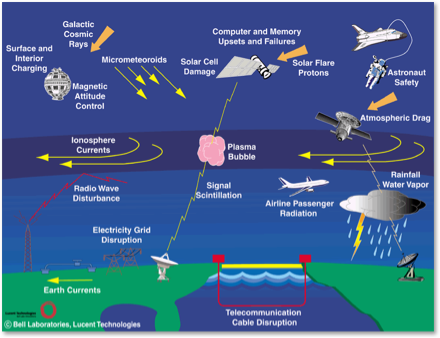What is Heliophysics?
What is Heliophysics?
Heliophysics is the study of the domain of the Sun-the heliosphere-from the nuclear core in the center of the Sun where hydrogen is transmuted into helium, producing the energy that drives changes throughout the entire solar system, to the edge of interplanetary space where the solar wind and magnetic fields cede control of the local physical conditions to the interstellar medium. That represents over a volume of over 108 AU 3 suffused with outflowing plasma, magnetic fields, and solar radiation, with temperatures ranging from near absolute zero to over 20 MK.
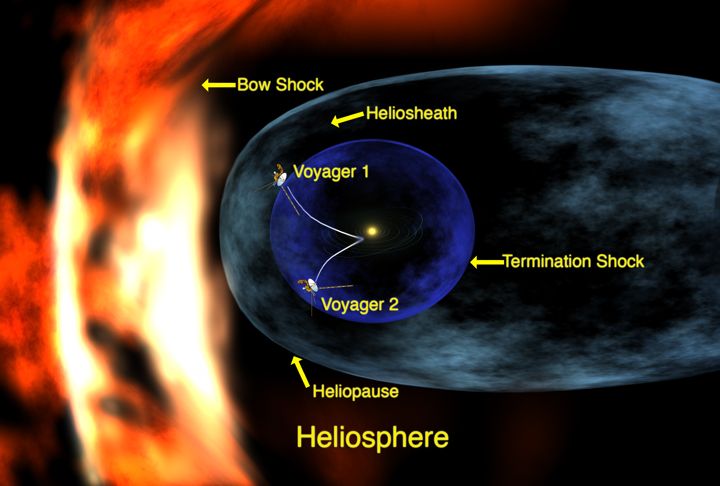
The Heliosphere |
The heliosphere is an interconnected network of physical processes driven by a relentless but varying outflow of energy from the Sun in the form of electromagnetic radiation from y-rays to radio emissions, charged and neutral particles, and magnetic fields. All these forms of solar emissions interact in different ways in the wide range of environments from the hot solar interior, through the Sun's thin surface layers, into the extended solar corona, and throughout interplanetary space to the very edge of the solar system. Along their tortuous path, these emissions interact with different planetary environments, comets, asteroids, and interstellar gas- each with its unique response to the changing solar stimuli. HSD's goal is to understand this system of systems.
Accomplishing this goal involves the study of the complex interactions between electromagnetic radiation, thermal plasmas, energetic particles, and magnetic fields, with three principal objectives:
- To understand the changing flow of energy and matter throughout the Sun, solar atmosphere, heliosphere, and planetary environments
- To explore the fundamental physical processes that characterize space plasmas
- To define both the origins and the societal impacts of variability in the Sun-Earth system
There are four major physical domains that encompass HSD's mission: the Sun, the inner heliosphere, geospace, and the outer heliosphere. In addition, each planet, moon, asteroid, and comet interacts with the solar output in a different way depending on its size, distance from the Sun, atmospheric composition, axial tilt, orbital eccentricity, and magnetic field. The Sun also interacts with the interstellar medium in a boundary layer called the heliopause.
Heliophysics has practical applications as well. Solar variability leads to a dynamically variable near Earth environment with impacts on technological systems both in space and on the ground, and corresponding effects on life and society. This is referred to as "space weather."
Space weather has direct effects on satellite orbits, electronics, power systems, sensors, communications, GPS, power and energy industry, and commercial aviation. It is a concern in the realm of national defense and will be a major safety factor for deep-space exploration.
The Sun
The Sun not only generates radiant energy and accelerates particles, but also produces magnetic fields. The solar dynamo, driven by both radial and latitudinal differential rotation, generates magnetic fields and stores vast amounts of energy in them. Convection in the outer layers of the Sun and the natural buoyancy of the flux ropes drag these strong fields (>1000 G) to the surface, as evidenced by the presence of sunspots and faculae, which change the solar spectral irradiance that provides the energy to drive Earth's weather and climate system. Thus, a significant change in solar irradiance could affect Earth's climate.
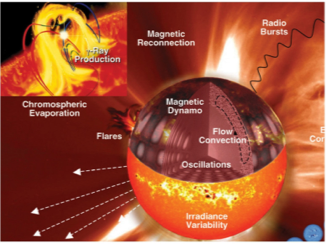
Anatomy of the Sun |
Energy is transported from the solar core region (the inner 20% of the solar radius) by photon radiation out to about 70% of the solar radius. Then convective transport takes over, carrying most of the energy to the surface of the Sun-the photosphere-where the optical depth of the solar plasma drops, so that much of the energy can be radiated away into space. The falling temperature gradient as the energy Bows outward seems well understood; however, just above the relatively cool surface layers, the temperature of the plasma rises rapidly again to form a 1-MK corona. The physical processes involved in creating and maintaining the corona are not completely understood as yet.
The energy stored in the solar magnetic fields is often released suddenly by rearrangements of the solar magnetic field, including magnetic reconnection, to produce Bares and coronal mass ejections (CMEs). Flares produce emissions from y-rays to radio wavelengths, accelerate solar energetic particles, and transport material from the lower layers of the atmosphere up into the hot corona via chromospheric evaporation, accompanied by ejection of material away from the Sun. CMEs are vast ejection events that can grow to be many times the size of the Sun and at times move with velocities exceeding 2000 km/s. Another type of mass outflow from the Sun is more continuous but also highly variable: the solar wind, which Bows out along the spiraling solar magnetic field with velocities of between 300 and 700 km/s with various temperatures, densities, and compositions. The manner of its acceleration is still not well understood.
The Inner Heliosphere
This is the region between the Sun and Jupiter that is filled with outflowing, supersonic solar wind and frozen-in spiraling magnetic fields—the Parker Spiral. The streams of solar plasma evolve significantly as they pass through this region, where fast streams of solar wind plough into slower-moving ones, forming shocks. Transients, such as CMEs, reshape the ambient environment. Some CMEs move faster than the local solar wind, building up high-density fronts that form shocks where particles are accelerated to extremely high energies. CMEs can expand as they move outwards, leaving low-density regions behind the propagating front.
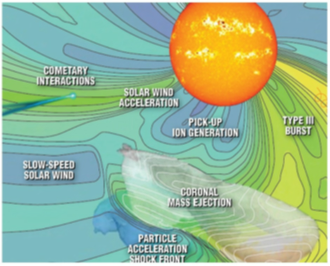
CME Propagates |
Electrons Bow along the large-scale magnetic field lines, producing radio bursts of various types, and showing which field lines remain connected back to the Sun and which ones have reconnected. Because of the spiral nature of the fields, Earth is better connected to the west limb of the Sun; thus, an event at or near the west limb is more likely to be geoeffective than one in the eastern hemisphere of the Sun. Photons take only 8 min to arrive at Earth from the Sun, and high-energy protons can be detected a few minutes later, whereas lower speed material from a CME event seen on the Sun may take up to 3 days to arrive.
Geospace
Earth's magnetic field acts as a barrier to most of the harmful particle fluxes originating from the Sun. Much of the solar wind is directed around the magnetosphere, which forms a teardrop-shaped shield around Earth. The shape and size of the magnetosphere change as solar wind conditions vary. Earth's magnetic field is compressed within about 10 RE on the sunward side of the planet and is stretched out by many tens of Earth radii on the anti-sunward side. The faster and denser the winds, the more the fields are compressed and stretched. The direction of the interplanetary magnetic field profoundly influences the Sun-Earth interactions. ACME with a dominant southward magnetic field oppositely directed to the interplanetary field will more likely reconnect, allowing more energetic particles to enter geospace and producing strong geomagnetic storm.
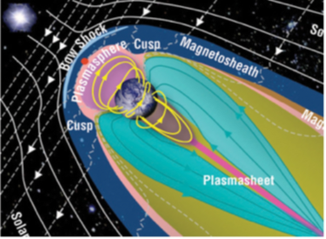
The complex structure of the Earth's magnetosphere |
Where the solar wind and Earth's magnetic field collide there is a bow shock region. The fields become weak and disorganized as they interact in the magnetosheath, the region between the bow shock and the magnetopause, which contains turbulent magnetic fields. The magnetopause is the irregular and highly variable surface where the Earth's magnetic pressure is balanced by the solar wind. The magnetopause often ripples and flaps in the solar wind, and parts constantly magnetically reconnect and break away. Over the Earth's polar regions and the high-latitude "cusp" region, solar particles have access to the magnetosphere via open field lines that connect to the interplanetary field.
Closer to Earth, a completely different set of closely coupled processes dominate. Here, solar radiation plays a major role. UV light from the Sun, especially when enhanced by flare emissions, heats the neutral atmosphere, increasing its scale height and resulting in orbital drag experienced by spacecraft, reducing their orbital life.
Gravity waves propagate up from below in the neutral atmosphere. The thermosphere becomes partly ionized by absorbed solar emissions that heat it increasingly with altitude. As a result of changing inputs, it becomes highly dynamic. The ionosphere, the first completely ionized layer of Earth's atmosphere, becomes very disturbed at times of high solar activity; these disturbances, in turn, and interfere with many forms of HF radio communications, and cause bulk outflow of the ionosphere into the magnetosphere from the auroral zones. The Earth's radiation belts chiefly contain trapped populations of electrons and protons ranging in energy from a few hundred keV to tens of MeV The radiation belts overlap spatially with the plasmasphere containing low-energy (few to tens of keV) plasma, which sustains many different kinds of plasma waves. Structurally the radiation belts comprise an outer and inner belt separated by a slot region bereft of electrons. The outer belt comprises largely of trapped electrons, which are the result of energization of a low energy seed population supplied by substorms. Plasma waves play a dominant role in energizing these electrons to high energies.
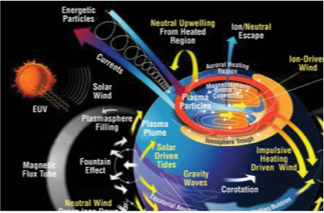
Some of the physical processes that occur when incoming radiation and charged particles interact with Earth's dynamic atmosphere |
The inner belt comprises largely protons resulting from the decay of cosmic ray neutrons as well as solar protons that are trapped by the nearly dipolar inner geomagnetic field. The process of energization and trapping occur not only in the terrestrial magnetosphere but also in other magnetized planets and in astrophysical contexts. Apart from scientific aspects, there is the practical necessity to understand the dynamics of these high-energy particles as they may cause deleterious effects to spacecraft and humans in space.
The Outer Heliosphere
The characteristics of the heliosphere significantly change past the orbit of Jupiter-this area is called the outer heliosphere. Here, the solar wind and transients interact with the gas-giant planets, which are very different from their rocky cousins in the inner heliosphere.
In this region, the nature of the outflowing plasma also changes; the interplanetary magnetic field becomes mostly azimuthal and therefore is perpendicular to the solar wind flow; this is where solar transients and interplanetary shocks catch up with each other and form large Global Merged Interaction Regions. In addition, a larger portion of the solar wind is composed of photoionized interstellar neutral particles, known as pickup ions.
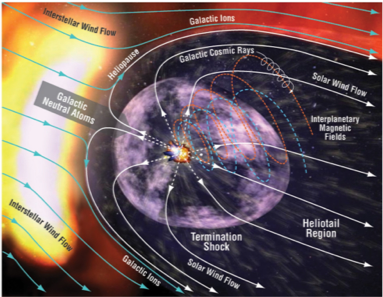 The interactions between the solar wind and the interstellar medium create a trange of unique phenomena |
With increasing distance from the Sun, the particle and field pressure of the solar wind decreases until it reaches pressure balance with the local interstellar medium. This boundary is called the heliopause; however, before reaching this boundary, the solar wind has to slow abruptly below its supersonic speed at the termination shock, and start deflecting toward the heliotail and continue slowing down in the region known as the heliosheath. The interaction of the heliosphere with the interstellar medium is analogous to the solar wind deflecting around Earth's magnetosphere. It is postulated that the interstellar plasma could also flow at supersonic speeds, necessitating the existence of an external bow shock and a pileup of interstellar particles upstream of the heliosphere, known as the hydrogen wall.
Besides low-energy neutral particles, the extremely high-energy galactic cosmic rays also enter the heliosphere, but not without first being modulated by the periodically varying heliospheric magnetic fields. The termination shock and heliosheath are also thought to be the source of an anomalous component of the cosmic rays observed at Earth.
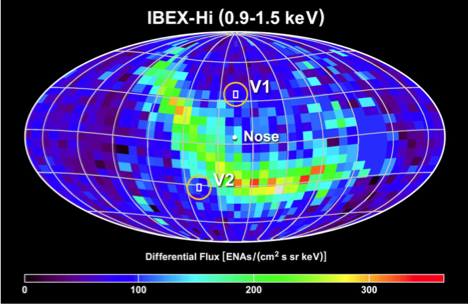 An ENA image of the outer heliosphere taken by the IBEX Hi channel (0.9 –1.5 keV showing the current locations of Voyager 1 (V1) and Voyager 2 (V2). |
The new technique of ENA imaging has given us our first images of the outer heliosphere from the IBEX Mission, and we are finding that the boundary is variable in both its intensity and structure.
Space Weather
Space weather refers to conditions on the Sun and in the solar wind, magnetosphere, ionosphere, and thermosphere that can influence the performance and reliability of space-borne and ground-based technological systems and can endanger human health. Adverse conditions in the space environment can cause disruption of satellite operations, communications, navigation, and electric power distribution grids, leading to a variety of sosioeconomic losses (US National Space Weather Program). Space weather is primarily a problem of modern high-tech society. Prior to introduction of the telegraph system in the 19th century, space weather could impact our everyday life only through the marvel of auroral displays often accompanied by strong geomagnetic storms. Since the 19th century we have witnessed both continuous introduction of new technology as well as new vulnerabilities to space weather (Fig. 1). For example, humans and spacecraft in space, HF radio communications, GPS and high-voltage power transmission systems are all known to be vulnerable to the fury of the Sun. It is clear that as our technology keeps advancing also the role of space weather phenomena interfering our daily lives is bound to increase.
|
Modern technological systems impacted by space weather phenomena. Also humans in space and at high altitudes can be exposed to hazardous space weather conditions. Credit: L. Lanzerotti. |
It is reasonable to think space weather as an interdisciplinary umbrella that covers fields from basic scientific research to engineering studies of technological impacts and from applied sciences to operational forecasting activities. It is due to the interdisciplinary nature of the art that virtually all aspects of heliophysics research tie into space weather via better understanding of solar, interplanetary, magnetospheric and upper atmospheric phenomena. Better understanding is reflected in new physics-based models and new observational capabilities that ultimately feed into new applications and, for example, new forecasting capability. Consequently, heliophysics can be considered as the physics of space weather with links to direct societal benefits.

